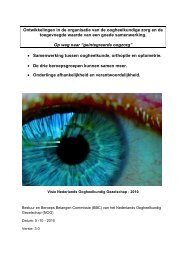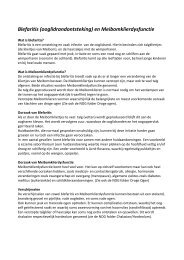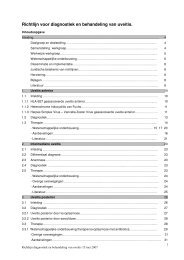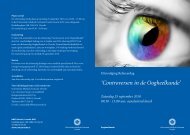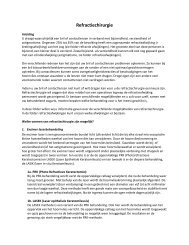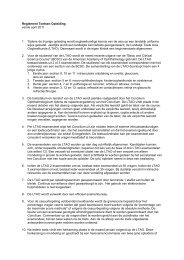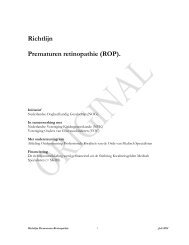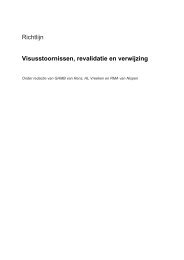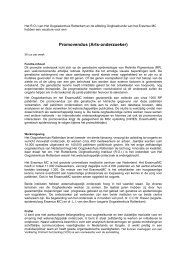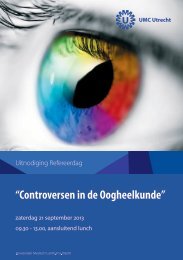terminology and guidelines for glaucoma ii - Kwaliteitskoepel
terminology and guidelines for glaucoma ii - Kwaliteitskoepel
terminology and guidelines for glaucoma ii - Kwaliteitskoepel
You also want an ePaper? Increase the reach of your titles
YUMPU automatically turns print PDFs into web optimized ePapers that Google loves.
1.1 - INTRAOCULAR PRESSURE<br />
Normal value of intraocular pressure (IOP)<br />
The ‘normal’ IOP is a statistical description of the range of IOP in the population, <strong>and</strong> is not applicable to the individual<br />
subject. There is some evidence that IOP increases by about 1 mm Hg with each decade after 40 years of age in<br />
most Western populations, although this does not appear to occur in all populations. The IOP follows a circadian cycle<br />
often with a maximum between 8 a.m. <strong>and</strong> 11 a.m. <strong>and</strong> a minimum between midnight <strong>and</strong> 2 a.m. This cycle is more<br />
dependent on the sleep cycle than the daylight cycle. The diurnal variation can be between 3 <strong>and</strong> 5 mm Hg<strong>and</strong> is wider<br />
in untreated <strong>glaucoma</strong> 1-5 .<br />
Anesthetic effects on the IOP measurement.<br />
The IOP measurement by applanation necessitates topical anaesthesia of the cornea, which does not affect the pressure.<br />
However, in young children, topical anaesthesia is not sufficient <strong>and</strong> a general anaesthetic has to be given. The most used<br />
substances are halothane (inhaled), ketamine (intra-muscular) <strong>and</strong> chloral hydrate (oral). In general, halothane lowers<br />
the IOP, whereas ketamine can cause a transient rise in IOP. Under ketamine the IOP is usually about 4 mm Hg higher<br />
than under halothane. Oxygen given during the anaesthesia has a hypotensive effect <strong>and</strong> carbon-dioxide a hypertensive<br />
effect. Succinylcholine can produce a transitory IOP increase of about 15 mm Hg. Nitrous oxide causes a slight increase<br />
in IOP 6-9 .<br />
Normal IOP in children.<br />
The IOP increases by about 1 mm Hg per 2 years between birth <strong>and</strong> the age of 12 years, rising from 6 to 8 mm Hg<br />
at birth to 12 ± 3 mm Hg at age 12.<br />
Normal IOP in adults <strong>and</strong> elderly.<br />
Normal IOP values are often based on population samples that may not be fully representative in their age distribution,<br />
as in the Framingham study where the mean age was 65 years <strong>and</strong> the mean IOP 16.5 mm Hg.<br />
Cornea<br />
Corneal characteristics that can affect the IOP measurements are corneal thickness, curvature <strong>and</strong> hydration 2,10-20 . The<br />
condition of the cornea should be considered both cross sectionally when comparing individuals or groups, <strong>and</strong> longitudinally<br />
when evaluating any patient. See next page.<br />
Other artifacts<br />
A tight collar or tie, Valsalva’s manovrer, holding breath, a lid speculum or squeezing the lids can all falsely increase<br />
the IOP reading 21 .<br />
Tonometry<br />
The principle of the method of tonometry is based on the relationship between the intraocular pressure <strong>and</strong> the <strong>for</strong>ce<br />
necessary to de<strong>for</strong>m the natural shape of the cornea by a given amount. The de<strong>for</strong>mation can be achieved by indentation,<br />
as with the Schiøtz tonometer, or by applanation, as with the Maklakoff <strong>and</strong> the Goldmann tonometers 2 .<br />
Although the pressure measured is external to the eye, the term used is “intraocular pressure” 7 .<br />
Method of measurement<br />
The most frequently used instrument is the Goldmann applanation tonometer, mounted at the slit lamp. The method<br />
involves illumination of the biprism tonometer head with a blue light obtained using a cobalt filter <strong>and</strong> applanation of<br />
the cornea after applying topical anaesthesia <strong>and</strong> fluorescein in the tear film. The scaled knob on the side of the instrument<br />
is then turned until the hemicircle of fluorescent tear meniscus visualized thorough each prism just overlap.<br />
Goldmann’s original equation is based on the Imbert- Fick law <strong>and</strong> assumed that: the cornea had a constant radius of<br />
curvture, the rigidity was the same in all eyes, the globe was spherical, aqueous would not mave away from the AC<br />
during measurement. This adds to the expected inter <strong>and</strong> intra observer variability 20 .<br />
Ch. 1 - 3 EGS



